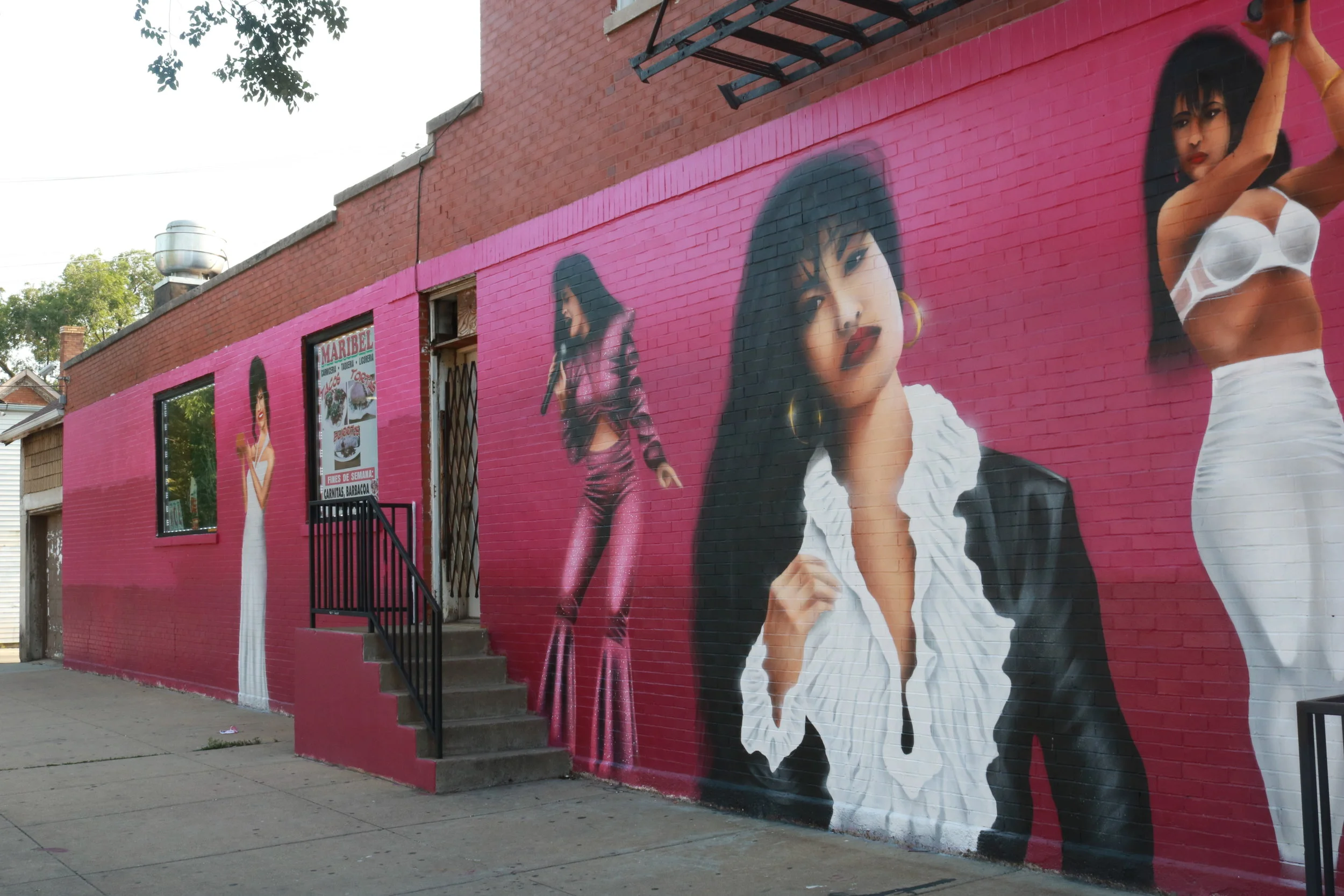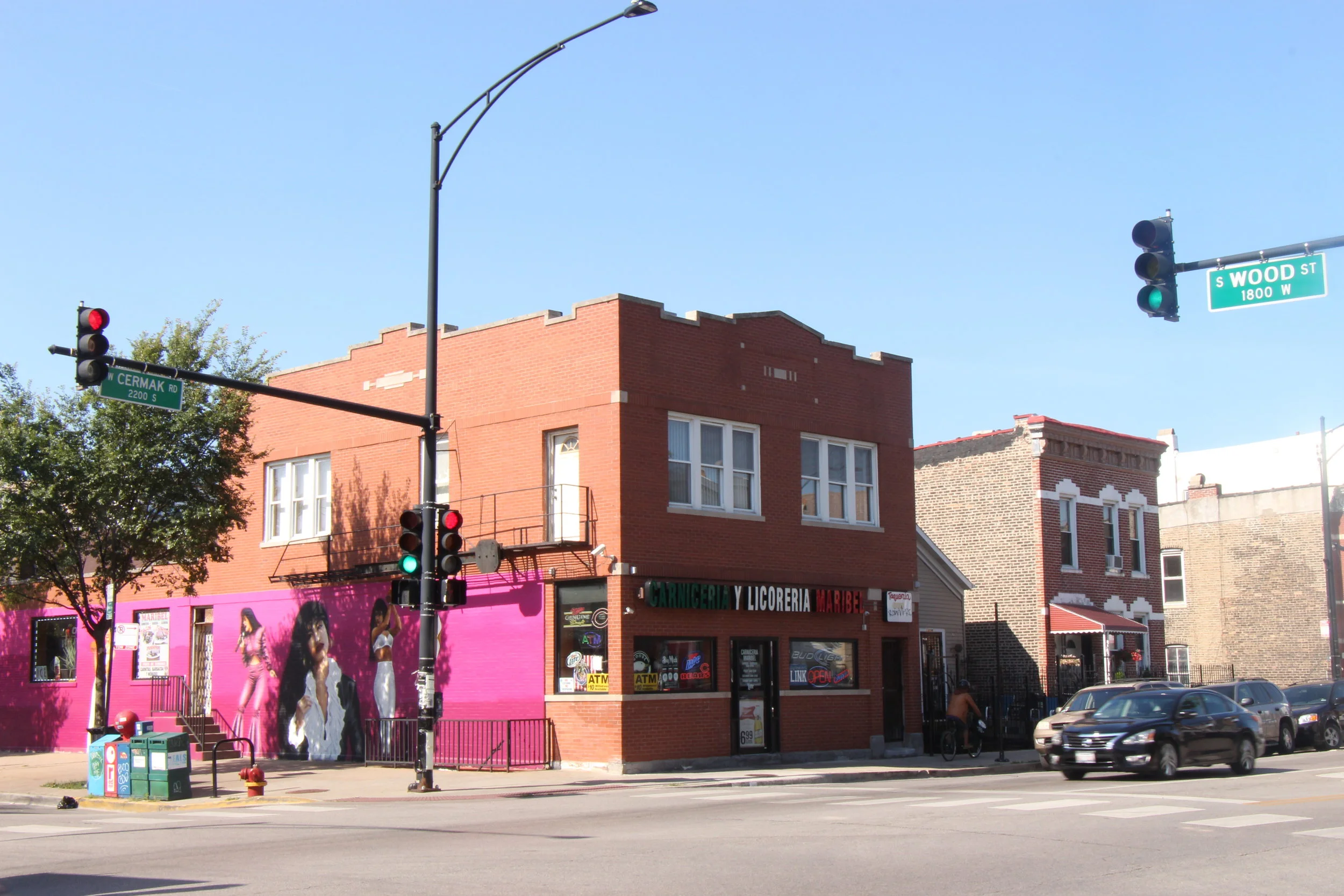The Selena Mural in Pilsen Is More Than Just Art
The Selena mural with the current four different images of her, located in Pilsen on the corner of Cermak Road and Wood Street at Carniceria Maribel.. Photo by Estefania Navarrete
On the corner of Wood Street and Cermak Road, right in the heart of Chicago’s Pilsen neighborhood is Caniceria Maribel, a corner store with a strong name and an even stronger place in the community.
According to Alejandro Banda, owner of Caniceria Maribel, the store has been open since 1990 and will soon celebrate its 30th year in existence. The store has a lot of history for the family that owns it and the community of Pilsen.
“Before it was bought by my mom her cousin that was the previous owner. My mom at that time was working in a factory. She was making minimum wage, she had to support three children,” Banda said.
Recently Banda was pitched with the idea of having a Selena mural painted on the wall facing Wood Street outside his store. The idea came from Mateo Zapata, the manager of the project and a customer of the store. “I talked to Alejandro about it, and he was all for it,” Zapata said.
According to Zapata, the mural project started about three months ago around May and is expected to be done by the end of August with five different faces of Selena painted. With four of the five Selena’s complete, Banda said he’s already witnessed a difference for Carniceria Maribel.
“It's a lot of customers that come in and are very proud of this,” Banda said. “Outside of that, you know, here and there we’ll get people that come in from taking pictures, take a look, maybe grab something, maybe not. But, I mean, that's one more customer than I would’ve ever had. So, to me, that's great.”
And it’s not just Chicagoans coming to see the mural. “There's people that drive here from Detroit and Waukegan, and people in California posting about it,” Zapata said. “And you know, there's definitely been a resurgence of even new customers that don't know about the store coming here.”
The artist responsible for the painting, Asend, said he will continue to do so until he feels it’s done. He has worked with graffiti for more than 20 years and mural work for three to five years.
“If any neighborhood in Chicago deserves a Selena mural, it’s Pilsen. I think Pilsen has Mexican-American history and generations of Mexicans and immigrants,” Asend said.
Which is the reason why a decision was made to add more of Selena to the mural, “ I have to paint this whole building. The neighborhood loved it so much that you know I have to blow it out of the water as much as I can. So now I’m on five images which will be the total,” Asend said.
With the mural mostly done and people from Chicago and beyond coming to see his art, Asend said he hopes he has done Selena justice. “[I want] to really show who she was as a whole, not just one image and to have the community connect and appreciate her.”
Zapata believe only a few artists in Chicago can do what Asend has done.
“I personally think that Asend is one of the best artists in the city,” Zapata said. “But I don't think he had a platform in this neighborhood at that point, and a lot of artists do stuff here. So I felt like it would be a good opportunity for him to shine as well.”
For many, the mural featuring Selena is special for many reasons. Even twenty-four years after her death, Selena Quintanilla is still considered by many to be an icon. The bilingual artist died in 1995 when she was just twenty-three years old. Her tragic death, done at the hands of friend and former fanclub president Yolanda Saldivar, has led many to try and commemorate her legendary career in their own ways.
“I thought about the fact that Selena should have a mural on a significantly visible space in Chicago, because she actually doesn't have one. She never did. So I just felt it was a little bit of a void.” said Zapata. “It’s music for English and Spanish. I think you get a lot of that in this neighborhood, a lot of very bilingual speaking generation,” Banda said.
Carniceria Maribel in the corner of Wood Street and Cermak Road, a Pilsen local business with the Selena mural. Photo by Estefania Navarrete
Selena often represents more than just music to those who are passionate about what she stood for and her journey as an artist.
“Selena represents the experience of growing up with immigrant parents. But growing up in the states also trying to navigate, you know, what's considered culture here and realizing that you have to make your own as opposed to fitting in.” Zapata said. “I think that some of the best ways to keep the younger generations of Latinos coming up, being proud of their heritage, and wanting to understand the value of something like art in the community is by kind of doing those kind of portraits of people that have been idolized.”
Although it’s a big deal having the first Selena mural in Pilsen on Carniceria Maribel, another message that Asend, Zapata, Banda and everyone behind the Selena mural hope is reflected through is the intersection between art and activism.
“I just think that it's a strategic solution to trying to fight against gentrification and making sure that Carniceria Maribel isn't ever going to be one of those businesses that has to fade away or that turns into like a four story tower building,” Zapata said.
“I think it goes to show that, you know, some guys that grew up here can really have an impact in their own neighborhood,” Banda said. “Like you don't have to just let things happen, you know. You can take charge in some ways and creatively make changes, alter things and perhaps keep your business.”
Zapata had a similar feeling, “I just hope it just shows other people, not just Latinos, whether it's the Black community or the Jewish community, or the Asian community, whether it be Chinese and Koreans, I think anybody that there's a value in beautifying your community and bringing walls that were once ugly for whatever reason to life with art,” he said.
Banda went on to explain that fighting for a community takes more than just believing something can change. He says it takes action and: “Not only for us to preach it, but also to practice it; that's one thing that we do.”



